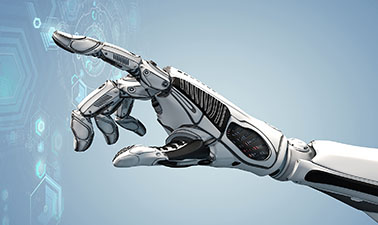It’s 2040. You’re going about your business when you feel your wearable health monitor buzz. One of its sensors has detected something’s not quite right. It’s looked up available doctors’ appointments, checked them against your diary and is asking you to confirm whether the time it’s found is convenient.
Rather than you visiting a surgery, the doctor comes to you later that day. It’s not a human doctor, but a robot. It arrives at your home in a self-driving car. Based on the data your wearable sent over, the robot doctor performs a physical examination on the affected part of your body. This reveals you need a scan, and there’s no waiting around for another appointment: the robot carries it out and analyses the result there and then, using the advanced artificial intelligence (AI) it’s equipped with. Based on its interpretation, the scan is then sent over to a human consultant to confirm the diagnosis that you need an operation.
While this isn’t what you wanted to hear, you won’t need to wait long: the operation can be performed the next evening. It’s a relatively routine procedure, meaning it can be done entirely by robotic machines. And so, just days after finding out something was amiss, you’ve been assessed and successfully treated, and are free to get on with life.
So what would it mean for patients if the scenario above was to become a reality? There would doubtless be concerns about such extensive use of robots and AI in healthcare, and the removal of so many human interactions. But there would also potentially be enormous benefits, would these outweigh people’s worries? Eli Neale, Client Services Manager, Softwire, explores.
Reality vs Fantasy
Wearables that monitor different aspects of our health are already all around us. These smart health devices form a key part of the wider connected wearable market, which is growing fast (though forecasts on how many wearables will be in use over the next few years vary from several hundred million to almost a billion).
Robots, too, are already exceptionally advanced – look at the recent example of Sophia, which uses advanced AI to learn from interactions and shape future behaviour. The company behind Sophia hopes to add consciousness to her already impressive list of skills within the next few years.
Research is also going on to explore how artificial intelligence can be used for the sort of screening described above. A recent example is the work undertaken by Moorfields Eye Hospital and DeepMind (owned by Google’s parent company Alphabet). The aim of this research is to investigate how machine learning (a form of AI) could help with the analysis of eye scans, and ultimately enable faster and more accurate diagnoses of eye conditions, leading to earlier treatment when required. Early results showed “promising signs” that this technique could benefit large numbers of people.
And elsewhere in healthcare, remote surgery is already a reality, with operations performed by robotic machines, controlled by surgeons who can be hundreds of miles away. Combine this with advances in AI, and it’s not too much of a stretch to imagine routine operations being done by robots that don’t require real-time human input.
The benefits of robots and AI in healthcare
The first big benefit is that robots and AI could free up significant amounts of time. With technology able to take on certain tasks, clinical staff would be able to spend longer on things the technology can’t (yet) do, such as complex operations and pioneering research. This could help drive down waiting times and accelerate medical breakthroughs.
Secondly, robots will eventually achieve the economies of scale that mean they cost less than human medical staff. With the population growing and people living longer, the need to do more with less budget becomes more pressing by the day. This will be one way of doing so.
Third, robots and AI can make it easier for everyone to access healthcare at any time. With robots you can create a truly 24×7 service that also makes maximum use of scarce facilities, such as operating theatres and scanners. Robots could also offer possibilities to reduce risk during operations, as they can be steadier than the human hand. If the robot doctor is also able to travel to a location convenient for the patient, it makes healthcare easier to access, particularly for those in remote communities or who find it difficult to get to a doctor’s surgery.
Potential risks and drawbacks
All of that said, there are genuine concerns about the extensive use of robotics and AI in healthcare. One of the things people appreciate when they go to the doctor is the empathy they get from speaking to a human – even with AI improving quickly, could it ever truly replicate this?
There may also be limits to the physical examinations a robot could carry out – or that we’d be happy allowing a robot to carry out on our own bodies. There may also be limits to a robot’s ability to tell the difference between certain things the way a human doctor could, meaning possible misdiagnosis (though misdiagnosis already happens today, so there’s a discussion to be had over whether other advances in AI and robotics would compensate and bring the overall rate down).
And, of course, there are all the questions around the security of sensitive data – if this is being stored within the robots, or they’re accessing it remotely, you’re opening up more surfaces to attack. Though not insurmountable, these issues would need addressing robustly if the system is going to remain watertight and people are to trust it.
Exciting opportunities
If even a few parts of our 2040 healthcare scenario are to come true, they’re going to rely heavily on AI, which means highly advanced algorithms, extremely sophisticated data manipulation capabilities and exceptionally secure software and infrastructure. AI could prove to be incredibly beneficial for the NHS but developers need to test this technology and its influence carefully to avoid losing consumer trust and any serious consequences.




